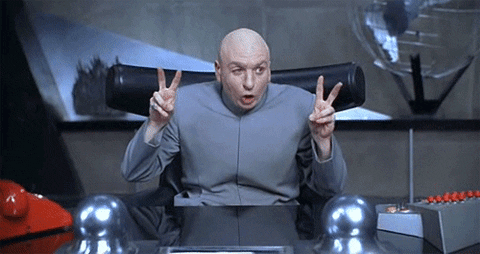Cookie Monster and The Hand with the Mind of Its Own

The image above comes from the 1999 movie “Austin Powers: International Man of Mystery.” Dr. Evil, the villain, is plotting ways to hold world governments for ransom. And in the gif above, he’s making what are colloquially known as “air quotes” — it’s a way for the speaker to indicate to their listeners that the actual word they’re using is a euphemism for something else. In Dr. Evil’s case, he’s not actually using air quotes correctly in the context of what he’s saying, but that’s not important for our purposes. Let’s instead focus on the actual motion. Here’s another gif of air quotes, this time employed by late-night talk show host Stephen Colbert:

Okay, let’s break this down:
Step 1: Bring both hands roughly to eye level.
Step 2: Extend the pointer and middle fingers on both hands.
Step 3: On both hands, simultaneously bend both sets of fingers a couple of times. Maybe waggle them a bit, too.
That may not be a perfect definition but it’s good enough, right? Let’s look at one more celebrity air quotes here — from the beloved Sesame Street character Cookie Monster.

Hands up to about eye level? Check.
Fingers extended? Yep.
Simultaneous finger bending? Well… not quite. It’s subtle, but if you pay close attention, it’s clear that Cookie Monster’s hands aren’t quite in sync with each other.
And there’s a good reason for that: Cookie Monster’s right hand has a brain of its own.
Here’s a secret — please don’t repeat it, as it’s bad for little kids to learn this: Cookie Monster isn’t really alive. He’s a puppet, and like any other puppet, he only comes to life when a performer picks him up and weaves his magic. (Sorry to ruin that for you.) He doesn’t have a skeletal system, a cardiovascular system, or a brain. He can’t move his mouth, arms, hands, or fingers by himself. So whenever you see them moving, it’s a person doing it for him.
And the math behind the movement doesn’t add up. Imagine you were the puppeteer performing Cookie Monster. To control his head and mouth, you’d lift your right arm up in the air. (If you’re not already miming these motions as you read them, you should; it’s fun. Arms up, people!) Then, you’d bring your left arm up to control his left hand. And then to control his right hand, you’d —
Wait. You’re out of arms. (Probably.) This is a problem!
In the puppetry space, there are a lot of ways around this. The most common is to use a “rod puppet,” like Elmo. Their arms are connected to rods that allow the performer to control the arms. But those puppets can’t pick up anything, as there’s no way for the puppets to grab things with their empty, felt-and-cloth hands. That wouldn’t work for Cookie Monster: he’d never be able to eat a cookie, and that’d be tragic.
So for puppets that need to pick things up, we need another solution. Those characters, called “live hand” puppets — have working hands. The left hand is performed by the main performer, joined by a second performer (often called a “right hand”) who squishes up next to the main performer and operates the right hand. That’s exactly what’s going on in the gif above; the person puppeteering Cookie Monster’s right hand is a different person than the one working on his head, mouth, and left hand. And as a result, the air quotes are unsynchronized. Each hand, literally, has a mind of its own.
Bonus fact: Cookie Monster’s friend, Big Bird, only has one brain — there’s a person inside that puppet. But that person, as a result, can’t see what’s going on around him. How does Big Bird’s puppeteer not bump into things? As performer (then the backup for main performer Caroll Spinney) Matt Vogel explained in the documentary I Am Big Bird (clip here), there’s a TV monitor inside the suit that he or Spinney would wear while inside the suit, showing him what the camera was capturing. When Big Bird isn’t on camera, he’s often wearing a tie — the tie, as Muppet Wiki explains, “is used to cover the vision hole” that the performer peers through to make sure the Bird doesn’t clumsily cause an accident.
From the Archives: Why Reusable Bags Often Have Cookies Inside: Or, why Cookie Monster does a lot of good deeds?
